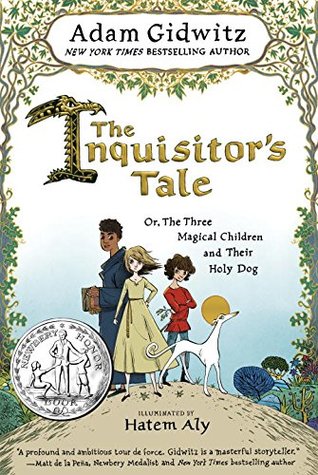Description: 1242. On a dark night, travelers from across France cross paths at an inn and begin to tell stories of three children. Their adventures take them on a chase through France: they are taken captive by knights, sit alongside a king, and save the land from a farting dragon. On the run to escape prejudice and persecution and save precious and holy texts from being burned, their quest drives them forward to a final showdown at Mont Saint-Michel, where all will come to question if these children can perform the miracles of saints.
Join William, an oblate on a mission from his monastery; Jacob, a Jewish boy who has fled his burning village; and Jeanne, a peasant girl who hides her prophetic visions. They are accompanied by Jeanne's loyal greyhound, Gwenforte . . . recently brought back from the dead. Told in multiple voices, in a style reminiscent of The Canterbury Tales, our narrator collects their stories and the saga of these three unlikely allies begins to come together.
Review: The Inquisitor's Tale is a book with a niche audience among younger readers and it will probably be most appreciated by adults with its clever nod to the The Canterbury Tales while weaving his own story in medieval France about three gifted children, a holy greyhound, and the people whose lives they touch. Like most tales of the Middle Ages it includes miracles, saints, villains, and dragons. The narrative structure is similar to The Canterbury Tales, as travelers gathered at an inn share what they know of the children who they claim are saints and have performed miracles. The children are diverse and come from different social classes within the society. Jeanne is a peasant girl with visions of the future much like Joan of Arc. William, an African moor whose parentage is of Christian and Muslim faith and is trying to become a monk and has incredible strength; Jacob is a Jewish boy with healing powers. Interestingly Gwenforte is the children's guardian greyhound who also has powers.
Religion and religious intolerance is the focus of the book along with other themes. The Abrahamic religions come into conflict and the children’s potential for sainthood is debated. The king executes an inquisition to apprehend these 'dangerous' children is what pushes the plot forward. Ten different narrators lend their voices to the tale—including a brewster, nun, butcher, librarian, and troubadour—while drinking a fair amount of ale, resulting in a loud, frank, conversational tone. There are some juvenile humor thrown in the book to lighten up the mood, but overall I think this book would be better suited for middle school readers who have a much better background and foundation of the Middle Ages in order to fully enjoy this tale.
Rating: 4 stars
Words of Caution: There is a character mentioned that is burned alive though it is not depicted graphically. Due to mature themes I would recommend this book to strong Grade 6 graders and up.
If you like this book try: For another book focused on the Inquisition and religion I would suggest The Passion of Dolssa by Julie Berry













Post a Comment